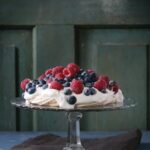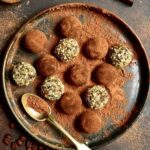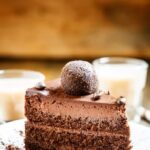Whipped cream, with its light and fluffy texture, can be a delicious and beautiful addition to any cake. Whether you’re looking to create a simple and elegant design or want to experiment with more intricate techniques, whipped cream offers a versatility that other frostings may not.
In this article, we’ll explore the various ways in which whipped cream can be used to decorate a cake, from basic piping to stenciling and beyond. We’ll also discuss the pros and cons of using whipped cream as a frosting, as well as tips for stabilizing it for decorating purposes.
When it comes to cake decoration, whipped cream is often overlooked in favor of buttercream or fondant. However, whipped cream can offer a lighter and fresher alternative that pairs well with many different flavor profiles. Its smooth and airy consistency allows for easy application on cakes of any shape or size, making it an ideal choice for both beginners and experienced bakers alike.
Not only does whipped cream provide a beautiful aesthetic to cakes, but it also adds a deliciously creamy taste that complements the flavors of the cake itself. Whether you’re decorating for a birthday party, wedding reception, or any other special occasion, using whipped cream as a frosting can elevate your cake to new heights of tastiness.
In the following sections of this article, we will delve deeper into understanding what exactly whipped cream is and how it differs from other frostings. We will also explore the pros and cons of using whipped cream for cake decoration, along with tips on how to stabilize it properly. Join us as we uncover different techniques such as piping and stenciling that can be used with whipped cream.
From troubleshooting common challenges to finding alternatives for different dietary requirements, we will cover all aspects of decorating a cake with whipped cream. So let’s dive in.
Understanding the Basics
Whipped cream is a popular choice for cake decoration due to its light and fluffy texture, as well as its delicious taste. Understanding the basics of whipped cream and how it differs from other frostings can help you make informed decisions when decorating cakes.
Whipped cream is made by beating heavy cream until it thickens and forms soft peaks. This process incorporates air into the cream, creating a light and airy texture. It is important to note that whipped cream is not as stable as other frostings, such as buttercream or fondant. It has a shorter shelf life and can melt easily in warm temperatures.
One key difference between whipped cream and other frostings is the ingredients used. Whipped cream only requires heavy cream, sugar, and flavorings like vanilla extract. Other frostings may use ingredients like butter, powdered sugar, and shortening. This makes whipped cream a simpler option for those who prefer a lighter frosting without any added fats.
Another difference lies in the taste and texture. Whipped cream has a subtle sweetness that complements the flavors of the cake well. Its light and fluffy texture provides a pleasant contrast to denser cake layers. On the other hand, other frostings like buttercream can be richer and sweeter.
| Frosting | Ingredients | Texture | Sweetness Level |
|---|---|---|---|
| Whipped Cream | Heavy Cream, Sugar, Flavorings | Light and Fluffy | Moderate |
| Buttercream | Butter, Powdered Sugar, Flavorings | Creamy and Smooth | Sweet |
| Fondant | Sugar, Water, Gelatin | Smooth and Firm | Moderate to Sweet |
The Pros and Cons of Using Whipped Cream for Cake Decoration
Whipped cream is a popular choice for cake decoration due to its light and fluffy texture, which adds an elegant touch to any dessert. However, like any frosting option, there are both pros and cons to consider when using whipped cream for cake decoration.
Pros of Using Whipped Cream for Cake Decoration
One of the major advantages of using whipped cream for cake decoration is its taste. Whipped cream has a delicate and creamy flavor that pairs well with a variety of cakes, making it a versatile option for different flavor combinations. It also adds a lightness to the overall taste of the cake, which can be particularly appealing for those who prefer less heavy and rich frostings.
Another pro of using whipped cream is its visual appeal. When properly prepared and applied, whipped cream creates a smooth and elegant finish on cakes. Its light color can act as a canvas or backdrop for other decorative elements, such as fresh fruits, chocolate shavings, or edible flowers.
Furthermore, whipped cream is easy to work with, requiring minimal skill and equipment compared to other more complex frosting options. It can be easily piped onto cakes using various designs or patterns for added visual interest.
Cons of Using Whipped Cream for Cake Decoration
While there are numerous benefits to using whipped cream for cake decoration, there are also some drawbacks to consider. One significant con is the stability of whipped cream compared to other frostings. Whipped cream has a tendency to melt at room temperature or when exposed to heat sources. This limits its use in certain climates or scenarios where refrigeration may not be readily available.
Additionally, whipped cream does not hold intricate designs as well as thicker frostings like buttercream. Its soft texture makes it challenging to create detailed piping work or complex decorations that require more structure.
Furthermore, unlike some buttercreams that can withstand long periods without losing their shape or appearance, cakes decorated with whipped cream need to be consumed relatively quickly to maintain their visual appeal. The softness and lightness of whipped cream can cause it to deflate, resulting in a less appealing cake appearance over time.
Overall, while there are limitations to using whipped cream for cake decoration, the pros often outweigh the cons for many bakers who value its light flavor, versatility, and easy application. With proper techniques and considerations given to certain challenges, whipped cream can be a delightful choice for decorating cakes of various occasions.
How to Stabilize Whipped Cream for Decorating Purposes
Whipped cream is a delightful and versatile frosting option for decorating cakes. However, it can be challenging to achieve the desired stability necessary for intricate designs and long-lasting decorations. Fortunately, there are several methods to stabilize whipped cream, ensuring that it holds its shape and stays on your cake without wilting or melting.
One popular method of stabilizing whipped cream is by using gelatin. Gelatin acts as a thickening agent, providing structure and stability to the whipped cream. To stabilize whipped cream with gelatin, start by dissolving gelatin in water according to the package instructions. Once dissolved, allow the mixture to cool slightly before incorporating it into your whipped cream while mixing on low speed. This technique helps prevent any lumps from forming and ensures even distribution of the stabilizer throughout the frosting.
Another way to stabilize whipped cream is by using cornstarch or powdered sugar. These ingredients absorb excess moisture in the whipped cream, preventing it from becoming too watery or limp. Simply mix a small amount of cornstarch or powdered sugar with your other dry ingredients before adding them to the whipped cream mixture. Be cautious when adding these stabilizers as using too much may result in a gritty texture.
For those who prefer an all-natural option or have dietary restrictions that prevent them from using gelatin, there are alternatives available. One popular alternative is using cream cheese as a stabilizer for whipped cream. Cream cheese not only adds stability but also adds a tangy flavor that complements many cake flavors. Another option is using instant pudding mix as both a flavoring agent and stabilizer for your whipped cream.
By implementing these techniques, you can confidently use stabilized whipped cream to create beautiful decorations on cakes without worrying about them collapsing or losing their shape over time. Experiment with different methods until you find one that suits your preferences and meets any dietary requirements you may have.
Exploring Different Techniques
Whipped cream is not only delicious to eat, but it also offers a wide range of possibilities when it comes to decorating cakes. In this section, we will explore different techniques that can be used to create beautiful designs using whipped cream. From piping to stenciling and more, there are several ways to get creative with this versatile frosting.
One popular technique for decorating cakes with whipped cream is piping. Piping involves using a piping bag fitted with a nozzle to create different shapes and designs on the surface of the cake.
This method allows for precise control over the placement and consistency of the whipped cream, making it ideal for creating intricate patterns or writing messages on cakes. Whether you’re looking to make rosettes, borders, or even flowers, piping is a go-to technique for many cake decorators.
Another technique that can be used with whipped cream is stenciling. Stenciling involves placing a stencil onto the cake and then applying whipped cream over it. Once the stencil is removed, a design is left behind on the surface of the cake. This method is great for creating patterns or images that are more intricate or detailed than what can be achieved through piping alone. It also allows for consistency across multiple cakes if using the same stencil.
In addition to piping and stenciling, there are numerous other techniques that can be explored when decorating with whipped cream. These include using various tools such as spatulas or palette knives to create texture or smooth finishes, as well as incorporating different colors or flavors into the whipped cream itself for added visual appeal.
| Technique | Description |
|---|---|
| Rosette Piping | Create beautiful swirls resembling roses by using a star-shaped piping nozzle. |
| Stenciled Patterns | Use stencils to create intricate designs like lace or geometric patterns on the cake. |
| Smooth Finish | Use a palette knife to create a smooth and even layer of whipped cream on the cake’s surface. |
These are just a few examples, but the possibilities with whipped cream decoration are virtually endless. The key is to experiment and have fun with different techniques to bring your cake designs to life.
Top Tips for Successfully Decorating a Cake with Whipped Cream
Decorating a cake with whipped cream can add a light and fluffy touch to your creation. However, it can also be a bit tricky to work with due to its delicate nature. To help you successfully decorate a cake with whipped cream, here are some top tips:
- Chill your tools and ingredients: Before you begin decorating, it’s important to ensure that your whipped cream, piping bag, and any other tools you’ll be using are chilled. This will help the whipped cream hold its shape better and prevent it from melting too quickly.
- Use stabilized whipped cream: Whipped cream can sometimes become runny or lose its shape over time. To prevent this from happening, consider stabilizing your whipped cream with gelatin or cornstarch. These ingredients will give the whipped cream more stability and longevity as a frosting.
- Apply an even base layer: Start by applying a thin and even layer of whipped cream all over the cake. This will help create a smooth surface for further decoration. Use an offset spatula or palette knife for best results.
- Work in chilled conditions: Whipped cream is sensitive to heat and tends to melt quickly when exposed to warmth. Aim to decorate your cake in a cool environment or keep it refrigerated until just before serving.
- Don’t overbeat the whipped cream: Overbeating can cause the whipped cream to become grainy or eventually turn into butter. Stop beating once stiff peaks form to achieve the desired consistency for decorating.
- Practice different decorating techniques: Piping is one of the most popular techniques for decorating cakes with whipped cream. Invest in various piping tips to create different designs such as rosettes, shells, or borders. You can also experiment with stencils for creating intricate patterns on your cake.
- Add finishing touches just before serving: Whipped cream tends to soften over time, especially if it comes into contact with moisture from fruits or fillings. To maintain the freshness of your cake, add any fresh fruits, garnishes, or other finishing touches just before serving.
Remember that practice makes perfect when it comes to decorating with whipped cream. Be patient with yourself and don’t be afraid to try new techniques. With these top tips in mind, you’ll soon be creating beautifully decorated cakes that will impress your family and friends.
Whipped Cream Alternatives for Different Dietary Requirements
Whipped cream is a popular choice for cake decoration due to its light and airy texture. However, it may not be suitable for everyone, especially those with dietary restrictions or preferences. Fortunately, there are several whipped cream alternatives available that can still provide a delicious and visually appealing touch to your cakes.
For individuals who are lactose intolerant or following a dairy-free diet, there are non-dairy alternatives to whipped cream. One common option is coconut milk or coconut cream. When chilled, coconut milk separates into a thick layer that can be whipped just like traditional whipped cream. It has a subtle coconut flavor that pairs well with tropical-themed or fruity cakes.
Another alternative is soy-based whipped topping. Made from soybean oil and other plant-based ingredients, soy whipped topping closely resembles the taste and texture of regular whipped cream. It is a versatile option that can be used in various cake decorating techniques.
For those following a vegan lifestyle, aquafaba can be used as an unexpected but surprisingly effective substitute for whipped cream. Aquafaba is the liquid leftover from cooking legumes, usually chickpeas or white beans. When whisked vigorously, it transforms into a foam-like consistency similar to whipped cream. Its neutral taste makes it ideal for adding any desired flavors or sweeteners.
Individuals with gluten sensitivities or allergies can opt for gluten-free whipped creams made with alternative flours such as almond flour or rice flour. These flours create smooth and slightly nutty variations of traditional whipped creams that are perfect for decorating gluten-free cakes.
Troubleshooting
Common Challenge: Deflating Whipped Cream
Deflating whipped cream is a common challenge that many bakers face when using it for cake decoration. This happens when the cream loses its light and airy texture, becoming dense and heavy. The result is a cake that lacks the elegant and fluffy appearance you were aiming for.
To overcome this challenge, it’s important to ensure that the whipped cream is chilled throughout the decorating process. Warm temperatures can cause the cream to lose its structure quickly. Additionally, make sure to use a high-fat content cream, such as heavy cream or whipping cream, as they provide more stability.
Another technique to prevent deflation is stabilizing the whipped cream using gelatin or cornstarch. These ingredients act as binders, preventing the air bubbles from escaping and reducing the risk of deflation. Follow a reliable recipe or method that incorporates stabilizers for best results.
Common Challenge: Difficulty in Creating Detailed Designs
When using whipped cream for cake decoration, achieving intricate designs can be challenging due to its soft consistency. Piping delicate shapes or writing messages on a cake may prove difficult if the whipped cream is too loose.
A great solution to this challenge is to use a piping bag with different tips to create various shapes and patterns. This allows for greater control and precision when decorating your cake with whipped cream. Make sure that your whipped cream has achieved stiff peaks before filling the piping bag for better results.
Another technique worth trying is freezing your design first before applying it onto the cake surface. This extra step will firm up the whipped cream design, making it easier to transfer onto the cake without losing its shape.
Common Challenge: Stability in Changing Temperatures
One of the drawbacks of using whipped cream for cake decoration is its stability in warm temperatures. Whipped cream tends to melt quickly, especially in hot or humid climates, which can cause your cake to lose its decorative appeal.
To overcome this challenge, it is important to keep the cake refrigerated until serving time. Avoid exposing the decorated cake to warm environments for an extended period. If you know that the cake will be displayed in a warm setting, consider placing it on an ice pack or using a chilled dessert display case.
Additionally, selecting stabilizers such as cream stabilizer powder or powdered sugar can help maintain the stability of the whipped cream in changing temperatures. These ingredients enhance the structure and reduce melting.
Overall, as with any cake decoration method, practice makes perfect when using whipped cream. Don’t get discouraged if you face challenges initially – experiment with different techniques and tips until you find what works best for you.
Inspirational Whipped Cream Cake Designs for Various Occasions
In conclusion, whipped cream is a versatile and delicious option for decorating cakes. Whether you are making a simple birthday cake or an elaborate wedding creation, whipped cream can be used to create stunning designs that will impress your guests. With its light and fluffy texture, whipped cream adds a touch of elegance and decadence to any cake.
One of the benefits of using whipped cream as a decoration is its ability to be easily manipulated into various shapes and patterns. From piped rosettes and borders to intricate stenciled designs, the possibilities are endless. You can let your creativity run wild and experiment with different techniques to achieve the desired look for your cake.
However, it is important to note that whipped cream does have some limitations when it comes to stability. It can melt at room temperature or when exposed to heat, so it is essential to keep the cake refrigerated until serving time. Additionally, if you need your design to stay intact for an extended period of time, stabilizing agents such as gelatin or cornstarch may need to be added.
Frequently Asked Questions
Can you use whipped cream on top of a cake?
Yes, whipped cream is commonly used as a topping for cakes. Its light and fluffy texture adds an attractive and delectable touch to the overall presentation of the cake. To use whipped cream as a topping, it is important to ensure that the cake has cooled completely before adding the cream to prevent it from melting too quickly.
This can be done by spreading or piping the whipped cream evenly on top of the cake, using a spatula or a piping bag with a desired nozzle tip. Whipped cream can also be further decorated with fruits, sprinkles, chocolate shavings, or other edible embellishments to enhance the aesthetic appeal of the cake.
How to decorate cake with whipped cream?
Decorating a cake with whipped cream can be an enjoyable and creative process. After preparing and chilling the whipped cream, it can be piped onto the cake using various nozzles to create different designs such as rosettes, shells, or swirls. The edges of the cake can also be adorned with piped borders for an added decorative effect.
For more intricate decorations, specialized piping tips or tools such as stencils may be used to create patterns or shapes on top of the cake. It is important to handle the whipped cream gently during decorating to maintain its airy texture and ensure clean lines and designs.
Can you use whipped topping to decorate a cake?
While whipped topping is often used as a substitute for whipped cream, its texture and stability differ slightly due to its ingredients. Whipped topping tends to have a firmer hold than traditional whipped cream since it contains ingredients like stabilizers and hydrogenated oils along with sweeteners and flavorings.
This makes it suitable for creating certain types of decorations on cakes; however, caution should be exercised when using whipped topping in warmer temperatures or high humidity as it may melt faster than traditional whipped cream. Nevertheless, when handled carefully, whipped topping can still be utilized to create attractive decorations on cakes by employing techniques such as piping rosettes, borders, or other designs.

Welcome to my blog about home and family. This blog is a place where I will share my thoughts, ideas, and experiences related to these important topics. I am a stay-at-home mom with two young children. I hope you enjoy reading it! and may find some helpful tips and ideas that will make your home and family life even better!





